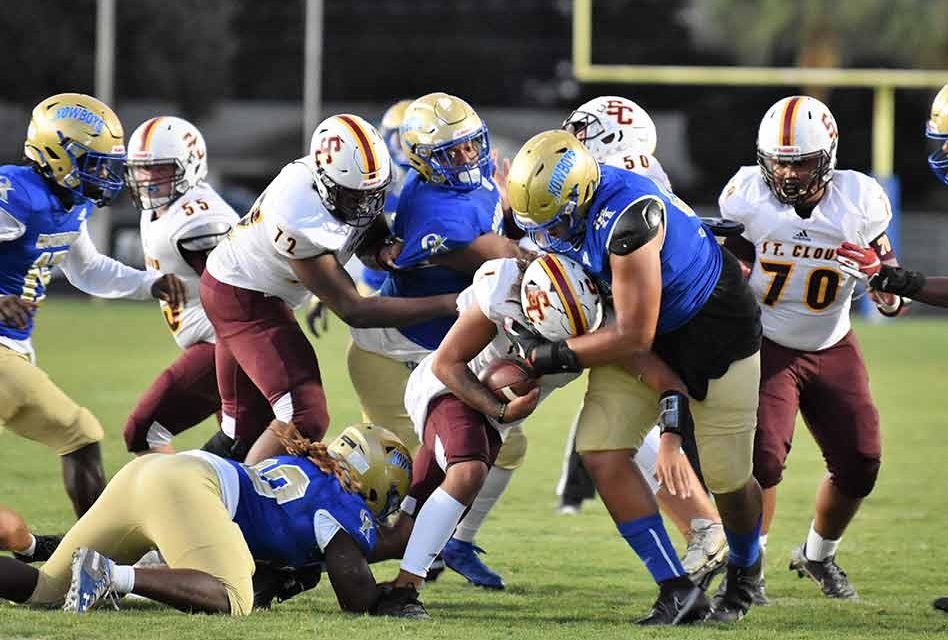A proposal that will be voted on next month may change the playoff landscape of Florida High School football.
Under the plan, the current single eight-classification system (1-A through 8-A based on school population) would be modified into two groups, the Metro Division and the Suburban Division. The Metro Division would consist of the eight most populous counties in Florida (Pinellas, Miami-Dade, Hillsborough, Palm Beach, Orange, Seminole, Duval and Broward), with the remaining 59 counties – including Osceola – forming the Suburban Division. Each division would have four classes (1A-4A) and would crown a state champion in each class.
The aim of the proposal is to create a more competitive balance and to give more teams an opportunity to compete for a state championship; while eliminating blowout games in the state finals. Since 2011, 87 percent of the 77 state titles up for grab have been won by what would be considered Metro Division schools; while only 35 different schools have even won a state championship in that time period.
One of the issues this plan hopes to solve is the built-in advantage schools in big metropolitan areas have in regards to accepting transfers. With some big city schools having five or six schools located within a couple of miles of each other, it becomes easier for a student-athlete to transfer to that school as transportation becomes less of an issue. While that will still take place, schools in more rural areas will not have to compete against those schools in the playoffs.
FHSAA officials also hope the plan reduces the number of lopsided playoff games, which has seen even state championship games go to a running clock under the mercy rule. For example, St. Thomas Aquinas won their five playoff games in Class 7A last year by an average of 30 points – including a 45-7 running clock win over Gainesville Bucholz in the semifinals. Under the new proposal, St. Thomas would be placed in the Metro Class 4A and would play teams from heavily populated counties in the post-season; while Gainesville Bucholz would compete in the Class 4A Suburban Division.
It is a plan that has divided reviews from Osceola County coaches and athletic directors. For Osceola High, which has been eliminated by what would have been classified as “Metro Division” schools in four of the last five seasons, it could create an easier path to the state championship – eliminating schools like Apopka, West Orange, Dr. Phillips, and Miami-based teams that have traditionally been in the Kowboys bracket.
“It’s an interesting proposal,” Osceola coach Eric Pinellas said. “I can’t say I am opposed to it and I know a lot of coaches are in favor of it. I don’t think there’s one plan – existing or proposed – that would make everyone happy. There are a few states that do something similar, so I see nothing wrong with giving it a shot.”
Other county coaches and administrators are indifferent. “Until I see how it will change things, it’s hard to say whether this plan would be a good thing or a bad thing,” St. Cloud coach Bryan Smart said. “There is some apprehension on in part as I believe we will be placed in the largest division and that would mean we might have to play bigger schools with many more students than we have.”
Smart’s boss, Athletic Director Eric Godfrey, said they are leaning towards supporting the proposal. “We will probably vote to approve it, but in the long run I don’t see it changing much for us,” Godfrey said.
Gateway coach Marlin Roberts says he is also indifferent. “Chances are Liberty and Poinciana are both going to remain independent, which means we will still probably be stuck in the same district with the Polk County schools. The proposal probably won’t hurt us, but I don’t see it helping us much either.”
Others, like Celebration athletic director Rick Tribit and Harmony coach Don Simon are opposed. Both said that open enrollment and school choice has created the competitive balance problem and that this proposal does not address that issue. “The biggest problem right now is we have a system that allows kids to play wherever they want,” Simon said. “Until that issue is addressed, nothing really changes, except for maybe the names on top. What it really means is the top teams in the Suburban Division will no longer have to go through any big city schools to win a state title and in the long run, that may just make those teams even stronger. I really do understand what they are trying to accomplish, I just don’t think this proposal will solve the problem.”
“I can’t see this as any type of real solution. It may create an easier path for some Suburban schools to win a championship, but some of those schools are already taking advantage of the transfer rules the same way the big city schools are,” Tribit noted. “High school football is very much becoming like the transfer portal in colleges and this plan really doesn’t address the problem that creates.”
Tribit is also concerned about what could happen if the plan does not create the desired results. “The FHSAA has a long history of not reverting its rules when they don’t work out, they just try to tweak them. It seems like they are rushing to get this in place as early as next year and I do not see what the hurry is. Some other ideas deserve some consideration,” he said.


















